As independent travelers; we typically don’t follow any of those “Top 10 Things to Do” lists in wherever it is we are going and that was not our intention when we booked a general tour of areas outside of Oaxaca City with Tomás Ramirez. However, by the end of a long day; we had hit virtually all of them.
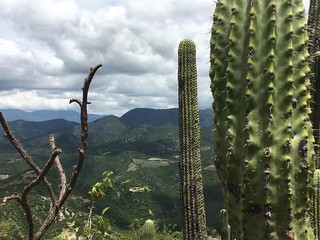
Tomás picked us up at our hotel in cento Oxaca in his very comfortable late model Chevy Suburban and we headed for the hills. Well actually we headed in a generally southeast direction with the Sierra Madre Oriental Mountain Range on one side of the road and the Sierra Madre Occidental on the other. Being the rainy season we passed through verdant green majestic countryside.
 Less than half an hour out of the city we made our first stop in the small community of Santa María del Tule and parked near the ancient Tree of Tule (Arbol del Tule); a cypress tree reported to be over 2,000 years old. I’m not sure if it measures up to its description as the largest tree in the world or not but I can report it is a massive presence almost as wide as it is tall; with both measuring an estimated 130 feet.
Less than half an hour out of the city we made our first stop in the small community of Santa María del Tule and parked near the ancient Tree of Tule (Arbol del Tule); a cypress tree reported to be over 2,000 years old. I’m not sure if it measures up to its description as the largest tree in the world or not but I can report it is a massive presence almost as wide as it is tall; with both measuring an estimated 130 feet.
To be perfectly honest, if Tomás had asked us if we wanted to go see a big tree when we began the day, I would have probably said “No. Let’s move on.” But after seeing the tree first hand, I was grateful for the experience.
As any reader of this web site probably knows by now, one person in our group has a special interest in textile arts. In fact, the opportunity to visit with Zapotec rug weavers was what first piqued our interest to plan a visit to Oaxaca. So that was one of the stops we had requested when we were setting up our tours.
Tomás could have picked from any of the hundreds of weaving workshops in the general area of Teotitlan del Valle to visit but he chose Casa Cruz, the farm/studio of acclaimed Master Weaver Fidel Cruz Lazo, his wife María Luis Mendoza de Cruz and his brother.
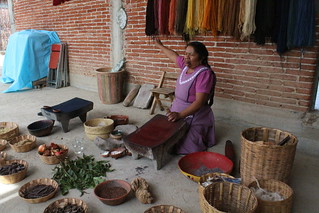 In addition to their skill as weavers of traditional Zapotec patterns, this talented couple has made a lifelong study of dyes made from natural products and our visit with them began with a very informative demonstration by Maria of preparing and using the traditional red dye made from the insect cochineal.
In addition to their skill as weavers of traditional Zapotec patterns, this talented couple has made a lifelong study of dyes made from natural products and our visit with them began with a very informative demonstration by Maria of preparing and using the traditional red dye made from the insect cochineal.
Cochineals are a scaly parasite that builds small powdery cocoons on host cactus paddles. They are collected and dried and then crushed into a powder on a stone table where their color changes from a gray stony appearance to a deep crimson. Mixed with water, it is ready to be used to dye cotton or wool fibers to be used in weaving.
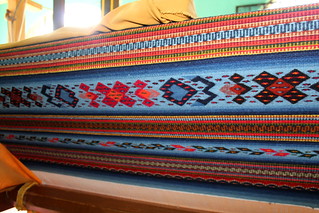 The couple uses Indigo for blues and lots of other natural organic products to make other colors. One of the exciting aspects to their work with natural dyes is that they continue to develop new colors by sourcing new products and by mixing new combinations of traditional dyes.
The couple uses Indigo for blues and lots of other natural organic products to make other colors. One of the exciting aspects to their work with natural dyes is that they continue to develop new colors by sourcing new products and by mixing new combinations of traditional dyes.
From Teotitlan del Valle we drove to and through the modern village of Mitla and then made a stop at the ruins of the same name. These grounds are not as large as the more famous ruins of Monte Alban but are still an impressive archaeological site in its own right.
The site was a home and religious center to the Zapote and Mixtec people for thousands of years before being occupied 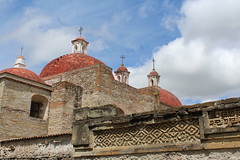 by the Spanish in 1520. Later in the 16th Century, the Spanish destroyed most of the ancient structures and materials from that destruction were used in new Spanish constructions like the Church of San Pablo, perched on a small hill overlooking the passageway into the ruins.
by the Spanish in 1520. Later in the 16th Century, the Spanish destroyed most of the ancient structures and materials from that destruction were used in new Spanish constructions like the Church of San Pablo, perched on a small hill overlooking the passageway into the ruins.
The remaining and restored buildings in Mitla are not so numerous or so impressive in size as some other archaeological sites 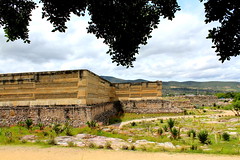 but are best known for the sharp distinct lines of the fitted geometric designs that cover many of the walls. We were told this feature is unique in Mexico.
but are best known for the sharp distinct lines of the fitted geometric designs that cover many of the walls. We were told this feature is unique in Mexico.
The most famous of the structures there are the altar at the Hall of Columns and the Patio de las Grecas a courtyard bordered by long rooms.
From Mitla we headed up the mountain to the town of San Lorenzo Albarradas and a small open air shack clinging to the side of a mountain top that houses the palenque known as “Mezcal Zompantle”. The master mezcalero here is Santos Martínez. We could see Santos tending his Espadin plants that spread down the mountain side but inside the shack was a mound of dirt covering the agave oven and his son tending a single steaming copper pot.
We took advantage of the opportunity to witness traditional production techniques and sample a wide range of handmade world class mezcals. A video of part of that visit is below:
A few days later we took a full day Mezcal excursion with Alvin Starkman. You can find a more complete report on our visit to Mezcal Zompantle as well as other palenques by clicking these links.
Our next stop was Hierve el Agua, a natural wonder that is only a short drive from “Mezcal Zompantle”. The views are amazing and the formation of the natural pools are  intriguing but the most remarkable feature at Hierve el Agua is a petrified water fall. I’m no geologist so I’m not certain “petrified” is the right word. My guess is that it was formed much like stalactites in a cave with minerals being gradually deposited until it reached solid ground.
intriguing but the most remarkable feature at Hierve el Agua is a petrified water fall. I’m no geologist so I’m not certain “petrified” is the right word. My guess is that it was formed much like stalactites in a cave with minerals being gradually deposited until it reached solid ground.
There is a natural spring fed pool with interesting formations where many visitors go for a swim but I’ve been told in the dry season that feature may not be available. And I would be remiss if I didn’t mention that the walks to the pool and even more so the walk 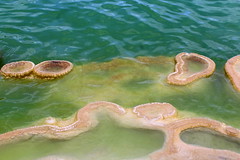 back up the hill are not easy.
back up the hill are not easy.
There are changing rooms and lots of small food and drink stalls as well as the typical vendors you would expect to find.
From Hierve el Agua, we headed back towards Oaxaca City and made a stop on the highway near Mitla at Rancho Zapata, the house restaurant at the Mezcal Benevá distillery. Benevá makes a decent product but is the largest Mezcal producer in Oaxaca so many of their production techniques are more industrial than the artisanal producers we were more interested in so we didn’t take “the tour” but did enjoy lunch.
We were very comfortable dining outside under a latticed wooden cover. The service was very good and the menu featured all the traditional regional favorites including a (very expensive) appetizer of ant eggs, Chapulines – the salty, spicy fried grasshoppers snack with a crunch and Tlayudas, a loaded crispy corn tortilla the size of and in the same concept of a large pizza. In general the prices were on the high side but the food was good and given the late hour; we were happy to have stopped there for lunch.
From there it was about an hour’s drive back to the city. It was a long but every enjoyable day and we got to see more of the regional attractions than we expected.
You can reach Tomás Ramirez by cell at 0449515072383 or email tomasramirez@prodigy.net.mx
